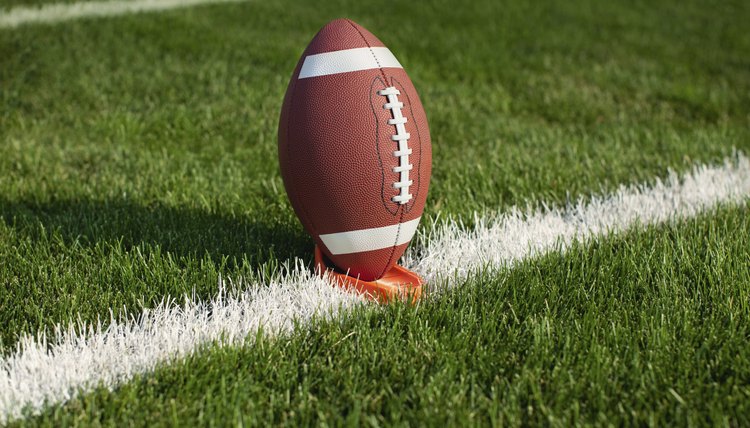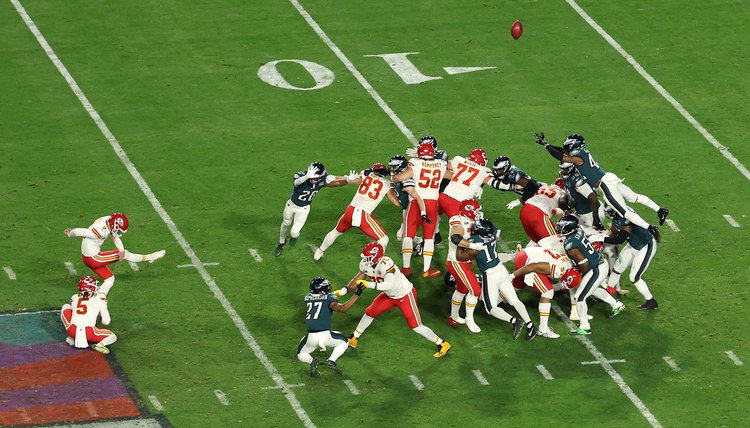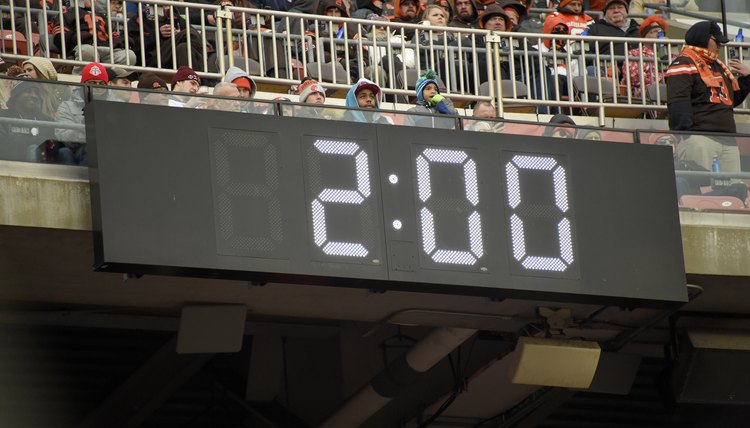High School Football Kickoff Rules (With Video)

The kickoff in football is one of the most exciting plays in a game because it marks the start of the game or transfer of possession after a score. Several basic rules are dedicated to organizing and regulating kickoffs, but every level and organization might have a variation in the rules. For example, high school football enforces kickoff rules based on the field layout and ability level of the players which vary from the ones you’d see in the NFL.
Setup
Along with the general outline and markings on the field, an X is painted on the middle of each 40-yard line to indicate the location of the tee position for the kicking team. However, the kicker can move the tee to another location on the same line if he chooses. The kickoff marks the beginning of each half of the game along with the transfer of possession after a touchdown or field goal. Each team has to have 11 players on the playing field during the kickoff.
Kicking Team

Willard/iStock/Getty Images
The kicking team is allowed to line up on its own end of the field behind the 40-yard line. The layout and positioning of the players can change as long as every player is behind the 40-yard line. As the kicker approaches the ball, he must kick the ball before any of the other players cross the 40-yard line. Once the ball is in the air, the kicking team players can use their hands to ward off any opponents from the receiving team who are attempting blocks on the kick return.
Receiving Team
The receiving team can line up in any pattern with the closest players to the kicking team limited to the 50-yard line. During the kick, the receiving team can set up blockers who can use unlocked hands and arms to block the kicking team. Any member of the receiving team can receive the kick and try to advance the ball. The receiving player, however, can use a fair-catch signal by waving his arm over his head before catching and securing the ball. A fair-catch marks the player down at the location of the catch. A kicked ball that goes into or past the endzone is a touchback which is placed at the 20-yard-line. This is different from professional and college football who have made the rule change to place kickoff return touchbacks at the 25-yard-line. Texas, however, uses NCAA rules for kick returns.
Clock

Willard/iStock/Getty Images
The game clock starts when the ball has been touched or caught by the receiving team. However, the clock doesn’t start if the ball goes out of bounds or is fair-caught by the receiving team. If the ball goes out of bounds before being touched by the receiving team, it is considered an illegal kick and the receiving team assumes possession at the location where it went out of bounds or 25 yards from the point of the kick, whichever is most advantageous to the receiving team.
What is the new NFL kickoff rule?
One rule that may reach high school football is the new kickoff rule created by Rich McKay and the NFL competition committee this offseason. This new fair catch rule emphasizes player safety by allowing kick returners to take a touchback anywhere before the 25-yard-line. The rule proposal has been controversial as many special teams coaches and head coaches believe it further takes away from kick off strategy. However, writers at ESPN pointed out that the league concussion rate on kickoffs surged since last season due to shallow kicks that don’t reach the endzone. Rule changes like this and the changes to the onside kick are important to Roger Goodell and the NFL owners as they try to change the narrative around the danger of football
What is the XFL and USFL kickoff rule?
While teams like the Packers, Jets, and Eagles grapple with that change, high school rules may adapt to those of the independent spring leagues. These kickoffs feature 10 players lining up on each side five yards apart. The players cannot move until the ball has been on the ground for three seconds or returned by the kick returner.
Writer Bio
Based in Nebraska, Jeremy Hoefs began writing fitness, nutrition, outdoor and hunting articles in 2006. His articles have been published in "Star City Sports," "Hunting Fitness Magazine" and RutWear field journals, as well as on the Western Whitetail website. Hoefs graduated with a Bachelor of Science in exercise science from Nebraska Wesleyan University.
